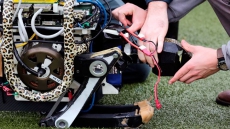Scientists at University of Waterloo have announced a breakthrough in lithium-sulphur technology to develop a new generation of cheaper, lighter and more powerful electric car battery.
Their discovery of a material that maintains a rechargeable sulphur cathode helps overcome a primary hurdle to building a lithium-sulphur (Li-S) battery.
Such a battery can theoretically power an electric car three times further than current lithium-ion batteries for the same weight - at much lower cost.
"This is a major step forward and brings the lithium-sulphur battery one step closer to reality," said chemistry professor Linda Nazar from the faculty of science.
Sulphur as a battery material is extremely abundant, relatively light and very cheap.
Unfortunately, the sulphur cathode exhausts itself after only a few cycles because the sulphur dissolves into the electrolyte solution as it is reduced by incoming electrons to form polysulphides.
Nazar's group thought that porous carbons or graphenes could stabilise the polysulphides by physically trapping them.
The result is a high-performance cathode that can recharge more than 2000 cycles.
The surface reaction is similar to the chemical process behind Wackenroder's Solution discovered in 1845 during a golden age of German sulfur chemistry.
"Very few researchers study or even teach sulphur chemistry anymore. It is ironic we had to look so far back in the literature to understand something that may so radically change our future," Nazar pointed out.
The paper appeared in the journal Nature Communications.






